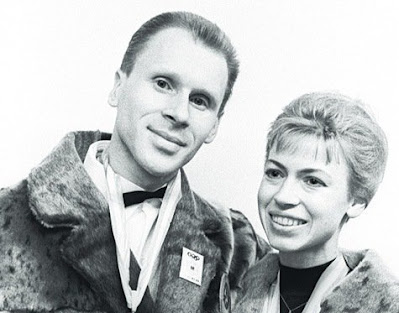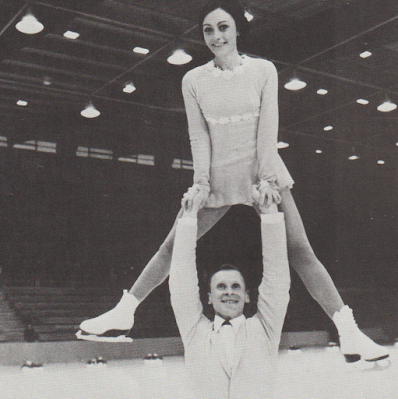In the aftermath of the infamous judging scandal at the 2002 Winter Olympic Games in Salt Lake City, there was a failed attempt to 'replace the ISU' by the World Skating Federation. Many high profile skaters got behind the movement for a time until the ISU and many of its member federations pushed back and thwarted the movement.
Two early advocates of the World Skating Federation were two-time Olympic Gold Medallists Ludmila and Oleg Protopopov. In April 2004, they shared a lengthy essay about skating governance, judging and the essence of artistry that was a fascinating read. With the recent passing of Oleg, it feels only fitting to revisit the Protopopov's profound words and share a few enlightening excerpts from this timeless piece. Despite the passage of two decades, their insights continue to resonate powerfully in the present day.
EXCERPTS FROM "MEDITATION ABOUT THE FUTURE OF THE WORLD FIGURE SKATING FAMILY, ISU - INTERNATIONAL SKATING UNION, NEW JUDGING SYSTEM, 'COP FOR JUDGES'? THE ISU CONGRESS OF 2004. IS FIGURE SKATING AN EXTREME OR ARTISTIC SPORT?" (LUDMILA AND OLEG PROTOPOPOV)
Ludmila and Oleg Protopopov
"When I was sixteen years old, my mother, a former classical ballerina bought a magazine 'America' (in Russian) at the black market. It was in 1948 in former Leningrad right before the 'Cold War between Soviet Union and the U.S.A. My mother's professional sharp eyes were attracted by beautiful picture of Dick Button in a split jump with perfectly extended points. My Mom said: 'Oleg, you must do better than this American guy'. Since, Dick Button became my ideal for his expressiveness, beauty and dynamic which were very good seen even on the picture. I have never met him personally until 1962 World Championships in Prague when he became an ABC TV sport commentator and I and my wife Ludmila became first time in our life World silver medallists in pair skating. Our first international debut with Ludmila at the European and World Championships was in 1958 where we had first opportunity in our life to watch the outstanding skaters of the West. It was the greatest shock which change our vision and understanding of the figure skating for the entire life, especially that we were Soviet sportsmen from the country with the Iron Curtain. We never had seen live double Axel several times in a row, without long preparation, executed by David Jenkins or Don Jackson's triple Salchow or top of elegance pair skating of Barbara Wagner-Bob Paul. They did not skate their programs, they danced them so musically that it was hard to believe that they did it on the skates. Since, they became as live example for us and we call them the Gold Generation, who made great contribution to the World figure skating but the way they skated, unfortunately is forgotten and ignored today, despite the fact that their artistic and technical achievements and philosophy of skating were already forty to forty five years ahead of time."
"We met each other fifty years ago in August of 1954 on the skating seminar in Moscow at the first in Soviet Union 9x9 m (27x27 feet) experimental artificial ice-rink. It was so small ice that we could not pass each other without touching by our hands. It was our first accidental pair spin but we did not suspect that it will be forever. In Leningrad, in December we began regular skating outdoor in wild winter cold (-15, -35 C) when we were almost twenty and twenty three years old, knowing nothing about figure skating, pair skating, without coach, choreographer, professional help, tape recorder, video camera, hard leather skating boots, attractive costumes, but with great love to the art of skating. Nevertheless, in 1962, '63, '64 we became silver medallists of the European and World Championships, Olympic champions after ten years of hard training in 1964, and 2nd time in 1968 after fourteen years of skating. Four times World Champions 1965-1968. We were ready to participate at the Olympic Games of 1972 but Soviet Figure Skating Federation using administrative power crossed out our plans, pointing out that we were too old, very theatrical, athletically weak, no speed, no difficult elements in the programs. But underneath of all this 'snow job' was the hidden rumours of our sport and administrable opponents, that Belousova-Protopopov will defect if they will win their 3rd Olympic Games. It was a real hit below the belt for everything what we did for the National sport and our Motherland. But from the other hand, it was good idea prompted to us, because we never thought about this before. We left Soviet Union in 1979. For this period of time we learn a lot of wise things from smart former figure skaters and coaches in the former Soviet Union, which they called 'Black Russian humor'. It is said: 'There are four categories of significance among the people in the modern figure skating: 1. The lowest categories are those who know how to skate, that is figure skaters. 2. The second, a bit higher, are those who don’t skate but teach. 3. The third, still higher, are those who neither skate nor teach, but judge. 4. The fourth and highest category are those who don’t know how to skate, don't teach, don’t judge but direct figure skating'. (Samson Gliaser - 1st coach of Ludmila Belousova in the former Soviet Union in 1951). We would not say that something radically changed in the attitude to the skaters until now. We are not going to say that: 'when we skated, it was great or better'. It was just different time."
"We remember the time (1979) when we left Soviet Union and all Soviet (eligible!) skaters, coaches and officials were not allowed to say 'Hello' to 'ineligible' Ludmila and Oleg Protopopov until 1992. In the former Soviet Union system, when a skater who was rejected to skate in the frame of the Sport Committee of the USSR, he or she automatically became 2nd grade person or 'ineligible', especially the skaters who had own vision, opinion, which differed from the official line. In spite of the Greatest Power, this system, fortunately, had collapsed."
"In Russia currently, the skaters must pay about ten percent commission from their prize money. They cannot receive it directly from the ISU but only indirectly from the Russian Figure Skating Federation. The ISU has not a deal directly with the skaters. Thus, National federations are the mini filial of the ISU structure. It can happen that the skaters even do not know for how much 'they are sold'. For example, we never knew that The Sport Committee of the USSR in 1968 got two thousand or twenty five hundred behind our backs for each Exhibition (fifteen) in the International ISU World Tour, while we, as an Amateurs (eligible) two time Olympic Champions and four time World & European champions had nothing from this money, except 'pocket' twenty five Swiss Francs from the ISU for each exhibition."
Ludmila and Oleg Protopopov
"Maxi Herber and Ernst Baier, Dick Button, Tenley Albright, Carol Heiss, [Ronnie] Robertson, David Jenkins, Barbara Wagner and Robert Paul, Donald Jackson, Peggy Fleming, Janet Lynn... it would be a great advantage to learn their dynamic technique of the short preparation to the jumps, musicality, the beauty of skating skills, and general culture of skating. Their ideals were Freedom, Flight, Grace, and Beauty. But today’s 'triple-quadmania' has killed this so important philosophy of the figure skating stressing primarily on the quantity of the jumps, revolutions and missing the Artistic and technical quality."
Peggy Fleming and Oleg Protopopov. Photo courtesy Ingrid Hunnewell.
"In 1960 Olympics (U.S.A) it was not required elements at all but skaters (men) did double Axel and triple jumps by own will without restriction or musts. But all pairs overhead lifts with full extension of the lifting arms were forbidden by the ISU after 1957, when Nina and Stanislav Zhuk (Soviet Union) demonstrated them first in the world at the European Championships in Vienna (Austria). Such a lifts were considered very dangerous ACROBATIC ELEMENTS and a pair would be punished (the ISU threatened!) in case of including forbidden lifts into the Free program which was 5min.10 sec. Nevertheless, it was allowed to lift only on the level of the shoulders. Now, forty seven years later, the ISU also will punish pair skaters but if they will not do overhead required lifts! By the way, nobody pushed [Donald] Jackson (Canada) to jump triple Lutz in 1962 Worlds. He did it by his own will and when he was ready to do it. Today the ISU wants to lead and dictate again, what to do and what is forbidden, like forty-seven years ago."
"We are not going to say that: ''when we skated, it was great or better''. It was just different time... Our main concern is that 'triple-quad-mania', 'paragraph-X-mania', 'record-mania' which make young figure skaters completely blind to the beauty and culture of skating and absolutely deaf to the music are not for the benefit of modern Sport and Art of Figure Skating."
"The nature of a skater from the very beginning is an artist. Remember American Jackson Haines who was the first in the World to skate - backed by an orchestra - the waltz, mazurka, quadrille, and march on the public holiday in Vienna in 1868. It was one hundred and thirty-six years ago! But modern artists of figure skating have to survive in the iron cage of the ISU rules, which make the space for artistic creativity in this cage smaller and smaller every year, forcing the skaters to be more robots on ice instead of human being personalities. Let the skaters skate how they physically CAN in a free program. Let the coaches, choreographers, and skaters to think themselves, as an artist, how to skate, how to compose, and what elements would be more expressive for particularly music. Let them to create independently (without ISU standards) new fresh innovative movements, combinations, elements and they will do their best according to the personal abilities, because it will be the best motivation to work. Variety is the spice of the life. Variety is the spice of figure skating."
Ludmila and Oleg Protopopov
"The foundation of figure skating is Artistic Figure Skating - the highest form of mastery. The beauty - is perfection of the simplest movements and the form of the body. If the movements and form of the body are beautiful - technically, they are perfect. The simplest moves are the most difficult in figure skating. The beauty will never get old, never lose its value, always be fresh and new."




